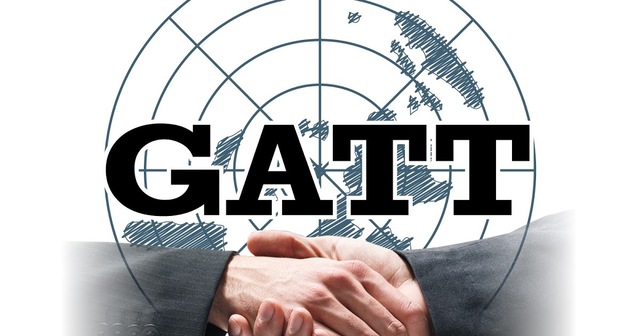Introduction for GATT Agreement-
The General Agreement on Tariffs and Trade (GATT) was an international trade agreement signed in 1947, aimed at reducing trade barriers and promoting a more open and integrated global trading system. The agreement was negotiated by 23 countries and served as the foundation for international trade for over 40 years. It was aimed at promoting economic growth and development in the post-World War II period by reducing tariffs, quotas, and other trade restrictions. The GATT was founded on the principles of most-favored-nation treatment and national treatment, ensuring that no country was discriminated against in trade. The agreement was also significant in establishing a framework for resolving disputes among member countries over trade issues.
Over the years, the GATT evolved through several rounds of negotiations, which resulted in significant reductions in trade barriers, particularly in developed countries. The most notable of these rounds was the Uruguay Round, which led to the establishment of the World Trade Organization (WTO) in 1995. The WTO built on the GATT’s achievements and addressed some of its limitations by expanding its scope to include services, intellectual property, and investment.
The GATT played a significant role in shaping the international trade system and promoting economic growth and development in the post-World War II period. Its legacy continues to influence global trade policy, and ongoing efforts to improve the international trade system reflect the continued importance of the GATT’s principles and achievements.
What is General Agreement on Tariffs and Trade?
The General Agreement on Tariffs and Trade (GATT) was replaced by the World Trade Organization (WTO) in 1995 because the GATT, which was established in 1947, was limited in its scope and had become outdated in the face of new challenges in international trade. The GATT was primarily focused on reducing tariffs on goods, and while it was successful in reducing trade barriers in some areas, it lacked provisions for addressing non-tariff barriers to trade, such as intellectual property rights and trade in services.
The WTO was established as a successor to the GATT to expand and modernize the international trading system. It was designed to be a more comprehensive and effective organization for regulating international trade, with a broader scope that included new areas such as trade in services, intellectual property, and investment. The WTO has a dispute settlement mechanism that allows members to resolve trade disputes in a more structured and binding manner than was possible under the GATT.
Overall, the WTO was established to provide a more effective framework for promoting and regulating international trade, in order to facilitate economic growth and development, and to ensure that trade is conducted in a fair and transparent manner.
What are the main objectives of GATT?
The General Agreement on Tariffs and Trade (GATT) was established in 1947 with the main objective of promoting international trade and economic growth by reducing trade barriers, such as tariffs and other restrictions on imports and exports. The specific objectives of the GATT were:
- To promote and encourage the expansion and liberalization of international trade in goods.
- To reduce trade barriers, including tariffs and other barriers to trade, through negotiations and agreements among member countries.
- To provide a framework for the orderly conduct of international trade, including the use of rules and procedures for settling disputes.
- To encourage the adoption of sound trade policies and practices among member countries, including the elimination of discriminatory practices and the use of non-discriminatory measures.
- To facilitate the participation of developing countries in the international trading system, and to ensure that they receive fair treatment in trade negotiations and agreements.
Overall, the main objective of the GATT was to promote free and fair trade among member countries, with the goal of increasing economic growth, creating employment opportunities, and improving living standards around the world.
What is the role of the General Agreement on Tariffs and Trade GATT?
The General Agreement on Tariffs and Trade (GATT) was a multilateral agreement between countries, established in 1947 with the objective of promoting international trade by reducing trade barriers, such as tariffs and other restrictions on imports and exports. The role of the GATT was to provide a framework for international trade negotiations and to facilitate the reduction of trade barriers.
The GATT had several key roles, including:
- Negotiating trade agreements: The GATT provided a forum for negotiations among member countries to reduce trade barriers, such as tariffs and quotas, and to liberalize trade in goods.
- Administering trade agreements: The GATT administered trade agreements reached through negotiations, ensuring that member countries adhered to their commitments to reduce trade barriers.
- Dispute settlement: The GATT provided a framework for resolving disputes among member countries over trade issues, including the use of tariffs and other trade measures.
- Providing technical assistance: The GATT provided technical assistance to developing countries to help them participate more effectively in international trade negotiations and to implement trade agreements.
The GATT played a significant role in promoting international trade and economic growth in the post-World War II period, helping to create a more open and integrated global trading system. The GATT was replaced by the World Trade Organization (WTO) in 1995, which continues to build on the achievements of the GATT and to promote free and fair trade among its member countries.
What is the General agreement on Tariff and trade GATT brief history?
The General Agreement on Tariffs and Trade (GATT) was a multilateral agreement between countries, established in 1947 with the objective of promoting international trade by reducing trade barriers, such as tariffs and other restrictions on imports and exports. Here is a brief history of the GATT:
- In 1947, representatives of 23 countries signed the GATT agreement in Geneva, Switzerland. The agreement was aimed at reducing tariffs and other trade barriers to help promote economic recovery after World War II.
- The GATT originally consisted of a set of rules for international trade and a mechanism for negotiating and enforcing trade agreements among member countries.
- Over time, the GATT membership grew to include more than 120 countries, and several rounds of trade negotiations were held to further liberalize trade in goods.
- The most significant of these rounds was the Uruguay Round, which took place from 1986 to 1994 and resulted in the creation of the World Trade Organization (WTO), which replaced the GATT as the international organization responsible for promoting free and fair trade among its member countries.
- During its existence, the GATT played a significant role in promoting international trade and economic growth, helping to create a more open and integrated global trading system.
- The GATT also provided a framework for resolving disputes among member countries over trade issues, including the use of tariffs and other trade measures.
- The GATT’s legacy is reflected in the rules and principles of the WTO, which continues to build on the achievements of the GATT and to promote free and fair trade among its member countries.
What is the importance of GATT in India?
The General Agreement on Tariffs and Trade (GATT) was important for India in several ways:
- Promoting international trade: GATT helped to promote international trade by reducing trade barriers, such as tariffs and other restrictions on imports and exports. This enabled Indian businesses to access new markets and to increase their exports, contributing to economic growth and development.
- Attracting foreign investment: By reducing trade barriers and providing a more predictable and stable trading environment, GATT helped to attract foreign investment to India, providing a boost to the economy.
- Providing a forum for trade negotiations: GATT provided a forum for India to negotiate trade agreements with other countries, including developed countries, which helped to increase market access for Indian exports.
- Supporting India’s economic development: GATT recognized the need for special and differential treatment for developing countries like India, allowing them to implement trade policies that were tailored to their specific economic development needs.
- Strengthening India’s participation in the global trading system: GATT played a key role in strengthening India’s participation in the global trading system, providing a framework for resolving trade disputes and ensuring that India’s trade interests were represented in international trade negotiations.
Overall, GATT played an important role in promoting international trade and economic development in India, helping to create a more open and integrated global trading system that continues to benefit India and other countries today.
Why was the GATT replaced by the World Trade Organization (WTO)?
The General Agreement on Tariffs and Trade (GATT) was replaced by the World Trade Organization (WTO) in 1995 for several reasons:
- Need for an updated and expanded framework: The GATT was established in 1947, and while it had been updated through several rounds of negotiations, it was seen as inadequate to deal with the complexities of modern trade issues, such as services and intellectual property. The WTO was established to provide a more comprehensive and updated framework for international trade.
- Expansion of the trade agenda: The WTO was established to expand the scope of the trade agenda beyond traditional trade in goods to include issues such as services, intellectual property, investment, and environmental regulations.
- Strengthening the dispute settlement system: The GATT had a dispute settlement system that was seen as slow and inefficient. The WTO’s dispute settlement system was designed to be more efficient and effective, providing a faster and more predictable mechanism for resolving trade disputes.
- Need for a permanent organization: The GATT was an interim agreement that was never intended to be a permanent organization. The WTO was established to provide a permanent institution to oversee the rules and principles of international trade.
- Need for greater participation: The GATT had a limited membership, and many developing countries were excluded from important decision-making processes. The WTO was established to provide greater participation for developing countries in the international trading system.
Overall, the establishment of the WTO was seen as necessary to provide a more comprehensive and updated framework for international trade, to expand the scope of the trade agenda, to strengthen the dispute settlement system, to provide a permanent organization, and to ensure greater participation for developing countries.
Key Features of GATT agreement-
The key features of the General Agreement on Tariffs and Trade (GATT) agreement include:
- Most-Favored-Nation (MFN) Treatment: The MFN principle is one of the key features of the GATT. It requires member countries to extend their lowest tariffs and other trade restrictions to all other member countries, ensuring that no country is discriminated against in trade.
- National Treatment: The national treatment principle requires member countries to treat imported goods the same way they treat their domestic goods. This means that imported goods should not be subject to discriminatory treatment, such as higher tariffs or other trade barriers.
- Tariff Reductions: The GATT was established with the objective of reducing tariffs and other trade barriers, promoting international trade and economic growth. To this end, member countries agreed to negotiate and reduce tariffs and other trade barriers through a series of rounds of negotiations, such as the Kennedy Round and the Uruguay Round.
- Non-Tariff Barriers: The GATT also addressed non-tariff barriers to trade, such as quotas, subsidies, and technical barriers to trade. Member countries agreed to negotiate and reduce these barriers to trade.
- Dispute Settlement: The GATT provided a mechanism for resolving disputes among member countries over trade issues, including the use of tariffs and other trade measures. Dispute settlement panels were established to hear and rule on disputes, and their decisions were binding on member countries.
- Special and Differential Treatment: The GATT recognized the need for special and differential treatment for developing countries, allowing them to implement trade policies that were tailored to their specific economic development needs.
Overall, the GATT was aimed at promoting international trade by reducing trade barriers and ensuring a more open and integrated global trading system, while also addressing the concerns of developing countries and providing a mechanism for resolving disputes among member countries over trade issues.
Critical Analysis of GATT Agreement-
The General Agreement on Tariffs and Trade (GATT) agreement was a landmark international trade agreement that played a significant role in promoting economic growth and development in the post-World War II period. However, the agreement also had its limitations and weaknesses, which have been the subject of criticism and debate over the years. Here are some critical analysis of the GATT agreement:
- Limited Scope: The GATT primarily focused on trade in goods and did not address issues related to services, intellectual property, investment, and other non-tariff barriers to trade. This limited scope left significant gaps in the international trade system that needed to be addressed.
- Discriminatory Treatment: While the GATT required MFN treatment, it allowed for exceptions such as regional trade agreements and the use of non-tariff barriers. This allowed some countries to discriminate against others in trade, undermining the spirit of the agreement.
- Special and Differential Treatment: The GATT recognized the need for special and differential treatment for developing countries but did not go far enough in addressing their concerns. Some critics argue that the agreement was biased in favor of developed countries, which had more bargaining power and were able to secure better deals.
- Dispute Settlement: While the GATT provided a mechanism for resolving disputes, some critics argue that the process was slow, inefficient, and biased in favor of developed countries. This led to concerns about the fairness and legitimacy of the dispute settlement system.
- Failure to Address Structural Issues: The GATT was primarily focused on reducing tariffs and other trade barriers but did not address the underlying structural issues that created trade imbalances and economic inequalities. This limited the effectiveness of the agreement in promoting sustainable and inclusive economic growth.
In conclusion, while the GATT was a significant achievement in promoting international trade and economic growth, it had its limitations and weaknesses. These included its limited scope, discriminatory treatment, bias towards developed countries, weaknesses in the dispute settlement system, and failure to address underlying structural issues. These criticisms highlight the need for ongoing efforts to strengthen and improve the international trade system to ensure that it is fair, inclusive, and sustainable for all.
Conclusion for GATT Agreement-
In conclusion, the General Agreement on Tariffs and Trade (GATT) was a landmark international trade agreement that played a significant role in promoting economic growth and development in the post-World War II period. The agreement was aimed at reducing trade barriers and promoting a more open and integrated global trading system.
The GATT’s most-favored-nation principle ensured that member countries extended their lowest tariffs and other trade restrictions to all other member countries, ensuring that no country was discriminated against in trade. The national treatment principle required member countries to treat imported goods the same way they treat their domestic goods, preventing discriminatory treatment of imports.
The GATT’s tariff reduction rounds resulted in significant reductions in trade barriers, and the agreement also addressed non-tariff barriers to trade, such as quotas, subsidies, and technical barriers to trade. The GATT provided a mechanism for resolving disputes among member countries over trade issues, and it recognized the need for special and differential treatment for developing countries.
However, the GATT also had its limitations and weaknesses. Its limited scope left significant gaps in the international trade system that needed to be addressed, and some critics argued that it was biased in favor of developed countries. Additionally, while the GATT provided a mechanism for resolving disputes, the process was slow and inefficient.
Despite its limitations, the GATT was a significant achievement in promoting international trade and economic growth, and it paved the way for the establishment of the World Trade Organization (WTO), which built on the GATT’s achievements and addressed some of its weaknesses. The ongoing efforts to improve the international trade system reflect the continued importance of the GATT’s legacy in shaping global trade policy.



